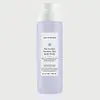What's inside
What's inside
 Key Ingredients
Key Ingredients

 Benefits
Benefits

 Concerns
Concerns

No concerns
 Ingredients Side-by-side
Ingredients Side-by-side

Water
Skin ConditioningSodium Cocoyl Isethionate
CleansingHydroxypropyl Starch Phosphate
Cocamidopropyl Hydroxysultaine
CleansingGlycerin
HumectantCoco-Glucoside
CleansingSodium Methyl Cocoyl Taurate
CleansingAvena Sativa Kernel Flour
AbrasiveAloe Barbadensis Leaf Juice
Skin ConditioningCalendula Officinalis Flower Extract
MaskingPanthenyl Hydroxypropyl Steardimonium Chloride
Chamomilla Recutita Flower Extract
MaskingGlycol Distearate
EmollientAlthaea Officinalis Root Extract
Skin ConditioningCamellia Sinensis Seed Extract
HumectantPhenoxyethanol
PreservativeCocamide Mipa
EmulsifyingEthylhexylglycerin
Skin ConditioningTetrasodium Glutamate Diacetate
Saccharomyces Ferment Lysate Filtrate
Skin ConditioningCitric Acid
BufferingWater, Sodium Cocoyl Isethionate, Hydroxypropyl Starch Phosphate, Cocamidopropyl Hydroxysultaine, Glycerin, Coco-Glucoside, Sodium Methyl Cocoyl Taurate, Avena Sativa Kernel Flour, Aloe Barbadensis Leaf Juice, Calendula Officinalis Flower Extract, Panthenyl Hydroxypropyl Steardimonium Chloride, Chamomilla Recutita Flower Extract, Glycol Distearate, Althaea Officinalis Root Extract, Camellia Sinensis Seed Extract, Phenoxyethanol, Cocamide Mipa, Ethylhexylglycerin, Tetrasodium Glutamate Diacetate, Saccharomyces Ferment Lysate Filtrate, Citric Acid
Water
Skin ConditioningCocamidopropyl Hydroxysultaine
CleansingAloe Barbadensis Leaf Juice
Skin ConditioningSodium Methyl 2-Sulfolaurate
CleansingDisodium 2-Sulfolaurate
CleansingCoco-Glucoside
CleansingGlycerin
HumectantGlyceryl Oleate
EmollientSodium Chloride
MaskingMandelic Acid
AntimicrobialCucumis Sativus Fruit Extract
EmollientCalendula Officinalis Flower Extract
MaskingBambusa Vulgaris Stem Extract
Palmaria Palmata Extract
Skin ProtectingCitric Acid
BufferingEthylhexylglycerin
Skin ConditioningCaprylyl Glycol
EmollientPhenethyl Alcohol
MaskingWater, Cocamidopropyl Hydroxysultaine, Aloe Barbadensis Leaf Juice, Sodium Methyl 2-Sulfolaurate, Disodium 2-Sulfolaurate, Coco-Glucoside, Glycerin, Glyceryl Oleate, Sodium Chloride, Mandelic Acid, Cucumis Sativus Fruit Extract, Calendula Officinalis Flower Extract, Bambusa Vulgaris Stem Extract, Palmaria Palmata Extract, Citric Acid, Ethylhexylglycerin, Caprylyl Glycol, Phenethyl Alcohol
Ingredients Explained
These ingredients are found in both products.
Ingredients higher up in an ingredient list are typically present in a larger amount.
Aloe Barbadensis Leaf Juice comes from leaves of the aloe plant. Aloe Barbadensis Leaf Juice is best known for helping to soothe sunburns. It is also anti-inflammatory, moisturizing, antiseptic, and can help heal wounds.
Aloe is packed with good stuff including Vitamins A, C, and E. These vitamins are antioxidants, which help fight free-radicals and the damage they may cause. Free-radicals are molecules that may damage your skin cells, such as pollution.
Aloe Barbadensis Leaf Juice also contains sugars. These sugars come in the form of monosaccharides and polysaccharides, folic acid, and choline. These sugars are able to help bind moisture to skin.
It also contains minerals such as calcium, 12 anthraquinones, fatty acids, amino acids, and Vitamin B12.
Learn more about Aloe Barbadensis Leaf JuiceCalendula Officinalis Flower Extract comes from the common Marigold plant. This ingredient is a skin conditioner.
Marigolds contain flavonoids. Flavonoids are a group of substances found naturally in plants. They possess antioxidant and inflammation properties.
This ingredient soothes skin inflammation by inhibiting inhibiting a part of the inflammation process.
Marigolds have been used in traditional medicine throughout Asia and Europe.
Learn more about Calendula Officinalis Flower ExtractCitric Acid is an alpha hydroxy acid (AHA) naturally found in citrus fruits like oranges, lemons, and limes.
Like other AHAs, citric acid can exfoliate skin by breaking down the bonds that hold dead skin cells together. This helps reveal smoother and brighter skin underneath.
However, this exfoliating effect only happens at high concentrations (20%) which can be hard to find in cosmetic products.
Due to this, citric acid is usually included in small amounts as a pH adjuster. This helps keep products slightly more acidic and compatible with skin's natural pH.
In skincare formulas, citric acid can:
While it can provide some skin benefits, research shows lactic acid and glycolic acid are generally more effective and less irritating exfoliants.
Most citric acid used in skincare today is made by fermenting sugars (usually from molasses). This synthetic version is identical to the natural citrus form but easier to stabilize and use in formulations.
Read more about some other popular AHA's here:
Learn more about Citric AcidCocamidopropyl Hydroxysultaine is a synthetic cleansing agent, though it is derived from coconut oil.
It is used to enhance the texture of products by boosting lather and thickening the texture. As a cleanser, Cocamidopropyl Hydroxysultaine is mild.
Coco-Glucoside is a surfactant, or a cleansing ingredient. It is made from glucose and coconut oil.
Surfactants help gather dirt, oil, and other pollutants from your skin to be rinsed away.
This ingredient is considered gentle and non-comedogenic. However, it may still be irritating for some.
Learn more about Coco-GlucosideEthylhexylglycerin (we can't pronounce this either) is commonly used as a preservative and skin softener. It is derived from glyceryl.
You might see Ethylhexylglycerin often paired with other preservatives such as phenoxyethanol. Ethylhexylglycerin has been found to increase the effectiveness of these other preservatives.
Glycerin is already naturally found in your skin. It helps moisturize and protect your skin.
A study from 2016 found glycerin to be more effective as a humectant than AHAs and hyaluronic acid.
As a humectant, it helps the skin stay hydrated by pulling moisture to your skin. The low molecular weight of glycerin allows it to pull moisture into the deeper layers of your skin.
Hydrated skin improves your skin barrier; Your skin barrier helps protect against irritants and bacteria.
Glycerin has also been found to have antimicrobial and antiviral properties. Due to these properties, glycerin is often used in wound and burn treatments.
In cosmetics, glycerin is usually derived from plants such as soybean or palm. However, it can also be sourced from animals, such as tallow or animal fat.
This ingredient is organic, colorless, odorless, and non-toxic.
Glycerin is the name for this ingredient in American English. British English uses Glycerol/Glycerine.
Learn more about GlycerinWater. It's the most common cosmetic ingredient of all. You'll usually see it at the top of ingredient lists, meaning that it makes up the largest part of the product.
So why is it so popular? Water most often acts as a solvent - this means that it helps dissolve other ingredients into the formulation.
You'll also recognize water as that liquid we all need to stay alive. If you see this, drink a glass of water. Stay hydrated!
Learn more about Water